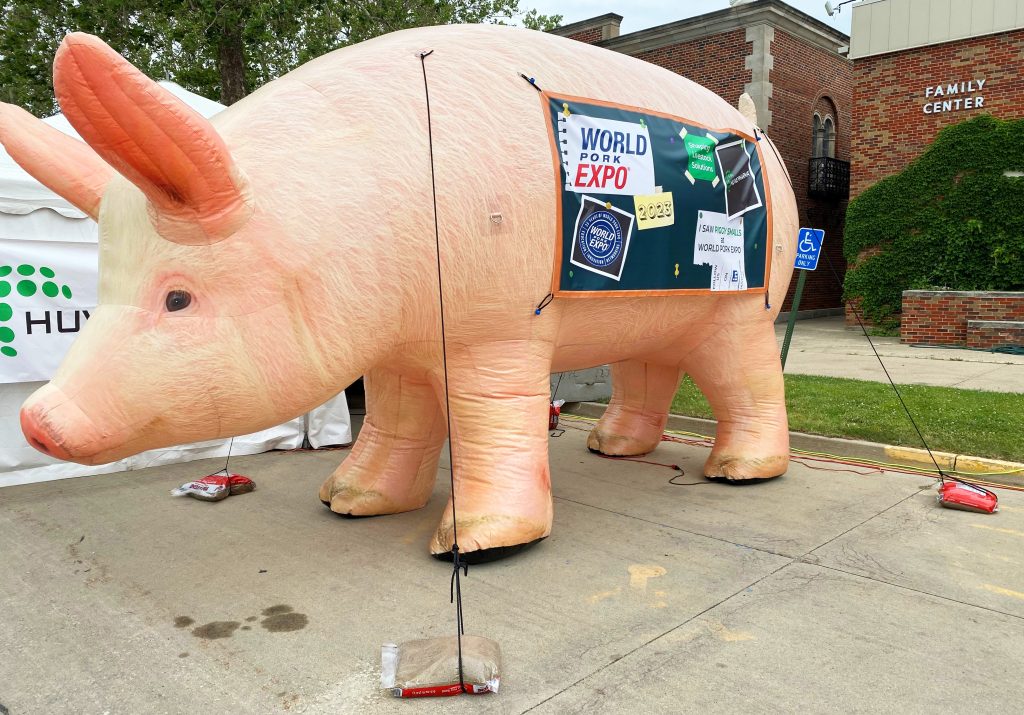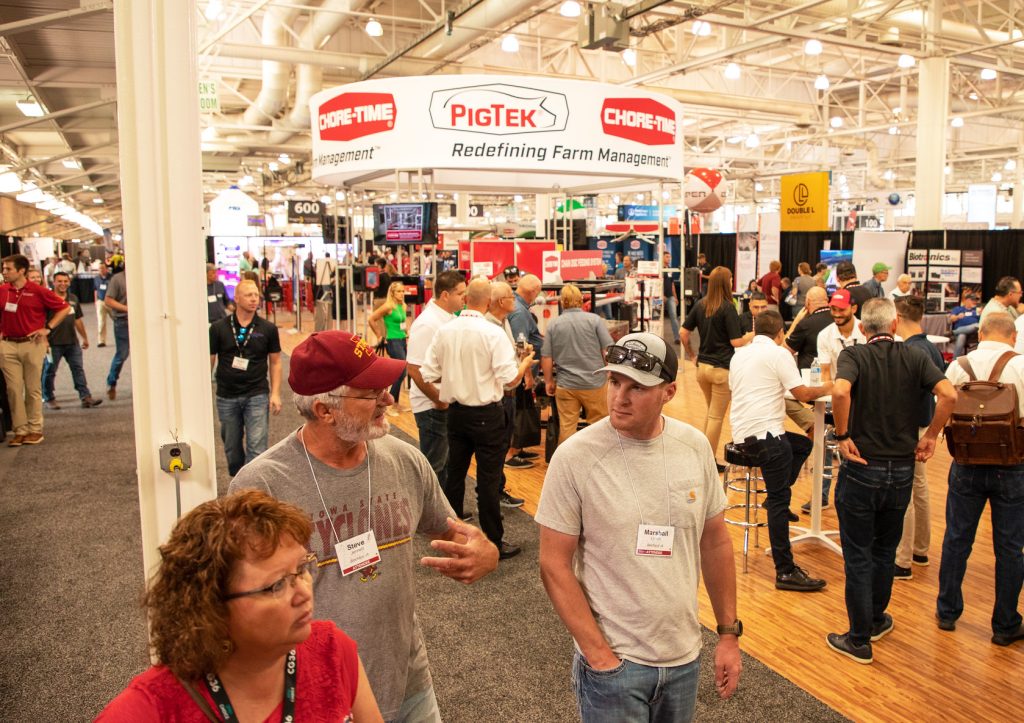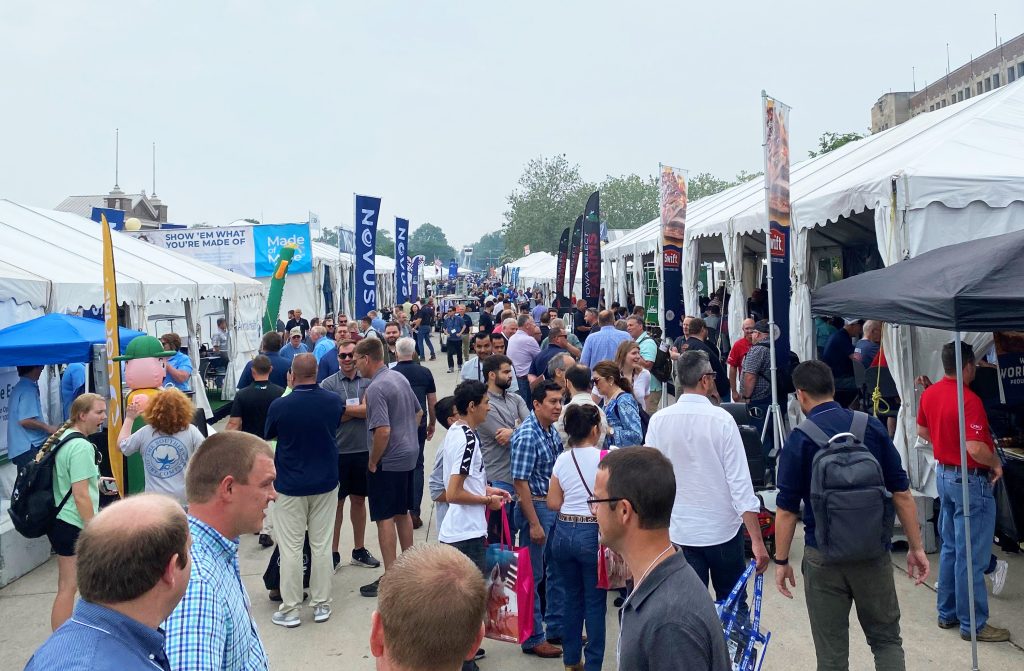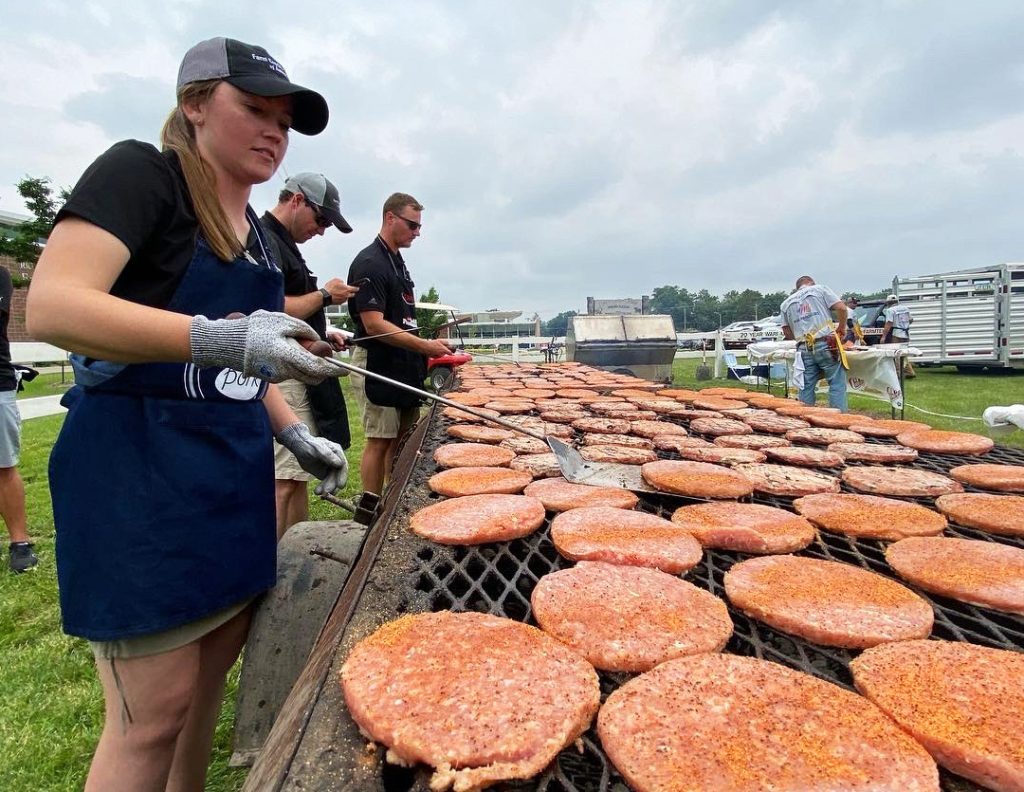By Andrew Heck

With a name like ‘World Pork Expo,’ and a claim to being the ‘world’s largest pork-specific trade show,’ the event has a lot to live up to. Without question, it positively shatters those expectations.
Taking place this year between June 7 and 9 in Des Moines, Iowa, World Pork Expo 2023 welcomed more than 10,000 hog producers and industry partners from all over. Situated in the heartland of America, this gathering is a must-attend event, featuring all the who’s-who of the pork industry.
World Pork Expo has a little something for everyone and delivers a whopping array of activities that are sure to educate, entertain and inspire across all three days it’s held. For us in Canada, it sets a high but achievable bar for what industry events can and should include, to attract attention and renown.
Why, oh why, Iowa?

Most people familiar with the pork industry would not be surprised that the Midwest U.S. is a major hub of hog activity. Indeed, it is the hub, with pigs in Iowa outnumbering people by about six-to-one. The state alone raises one-third of all U.S. hogs annually, representing approximately 46 million head – the most of any single state – and one-in-10 Iowans has a job tied to the industry.
Not only pig production, but pork processing is a considerable economic driver here, with the likes of Smithfield, Swift, Hormel and other prominent players operating in the surrounding area, serving many communities large and small. Across the U.S., there are 15 plants responsible for nearly 60 per cent of all hog slaughter, and of those, five are found in Iowa, with seven more in neighbouring states.
The World Pork Expo’s organizing partner, the National Pork Producers Council (NPPC), is also headquartered in Des Moines, making it a natural location to showcase what this proud industry has to offer. In nearby Ames, the main campus of Iowa State University is home to much of the cutting-edge research that helps the industry continuously improve pig performance and reduce its environmental footprint.
While Iowa is not likely the top choice for a U.S. holiday destination, for most foreigners, the state does serve a critical need when it comes to supporting food security for Americans from coast-to-coast, in addition to widespread economic benefits. Across Canada’s more remote stretches of farmland, where many of our pigs come from, and where many of you work and live, the situation is the same.
Producer issues placed front-and-centre

To kick off World Pork Expo, NPPC hosted a news conference, with thoughts shared by various organization representatives, primarily focused on recent legislative challenges.
Scott Hays, President, NPPC is a fifth-generation hog farmer from Missouri. Now that California Prop 12 is a done deal, legally speaking, he suggested the next steps should be to work with officials to implement it in the least-destructive way possible.
“Our immediate concern is keeping pork on shelves in California,” said Hays. “Our [NPPC] strength is what happens on the farm – the life cycle of the pig – and what’s a fair timeline for transitioning.”
But, for Hays, Prop 12 goes a lot deeper than economic considerations: “The poor don’t get high-quality pork they deserve; it doesn’t help the pigs; it’s morally wrong. That’s what we’re trying to do: protect producers and consumers.”
Regarding the resiliency of producers, and their ability to adapt to ever-changing conditions, Hays did, however, offer a hopeful message to counter the negativity: “Our ancestors figured it out, and so will we.”
Managing the trade implications of foreign animal disease remains top-of-mind to help make up for any lost domestic consumption, which may be the case, in light of Prop 12.
“The number-one priority for our industry is preventing a foreign animal disease from arriving on our shores,” said Maria Zieba, Vice President of International Affairs, NPPC.
Zieba mentioned Puerto Rico, a U.S. territory in the Caribbean, not far from the Dominican Republic, where African Swine Fever (ASF) was found in 2021. As the disease is considered endemic to the island of Hispaniola, where the Dominican Republic and Haiti are located, compartmentalization is key if a disease were to arrive in Puerto Rico, potentially affecting pork exports from the continental U.S. If trading partners choose not recognize a Puerto Rican compartment, it could prove disastrous.
“That would be highly unfair to producers in Iowa, Minnesota or anywhere in the U.S. outside Puerto Rico,” she said.
Lowering barriers to trade in Southeast Asia is one trade strategy NPPC is pursuing to diversify market access and insulate itself against political concerns. Zieba referenced making inroads in Vietnam as a way to compete with countries under the umbrella of the Comprehensive and Progressive Agreement for Trans-Pacific Partnership (CPTPP), which includes Canada.
When it comes to country-of-origin labelling for meat sold in the U.S., which has re-emerged as a topic of interest recently, Zieba expanded on NPPC’s logic when it comes to opposing its re-introduction, citing the increasingly integrated nature of the industry, especially with Canada and Mexico.
“Although the label would be voluntary, a lot of times, voluntary labels become mandatory. That’s just the way the market works,” she said.
Between 2008 and 2015, officials from the Canadian pork and beef industries effectively went to battle for Canadian producers in front of the World Trade Organization (WTO), citing the potentially costly and needless consequences of economic protectionism. The WTO ruled that country-of-origin labelling was, in fact, unfair to Canadian livestock shipped to the U.S., and struck it down. If it were to again be enacted, WTO compliance would result in retaliatory compensation for Canada, despite creating further headaches for the pork and beef industries on both sides of the border.
Given the scope of issues covered by NPPC, it is clear that the threats and opportunities expressed by the U.S. industry are many of the same we share in Canada. However, on a pound-for-pound (kilogram-for-kilogram?) basis, the potential risks and rewards are proportionally larger for Canada, given our heavier reliance on global conditions.
Trade show floor dwarfs most others

With nearly 400 booths total, featuring attendance from most of the world’s top swine industry suppliers, the World Pork Expo trade show floor could be considered the most-concentrated place anywhere to rub elbows with influential people in this business, including top brass from genetics and nutrition companies, equipment manufacturers, processors, government officials and others. The trade show provides a great chance to foster friendships and further commerce.
“Planning for World Pork Expo is a huge undertaking that begins for the next year almost immediately following the most-recent show,” said Randy Curless, Senior Marketing Specialist, PigTek. “Our company does not sell directly to producers, but through dealers, so the unique opportunity to build relationships with our end users at this event is invaluable for us.”
For some other vendors, promoting company research was the goal, as a way to pitch their products.
“World Pork Expo is a great place to connect with producers and people across the industry to showcase our work,” said Zach Rambo, North America Swine Manager, Zinpro Corporation. “Being able to network in-person helps us make the direct connections that get our products on-farm in the U.S., Canada and beyond.”
But not all exhibitors were there to sell products. Some, like U.S. Customs and Border Protection’s (CBP) agriculture specialists, were there to provide information on the risks of bringing contraband plant and animal products into the U.S. For the U.S. pork sector, as in Canada, a primary concern is the potential arrival of ASF from outside the country.
Several representatives from CBP were on-hand to answer questions and distribute materials to help attendees understand what they do and why it’s important. Curiously, not all CBP representatives were human.
Ozcar, one of CBP’s ‘beagle brigade’ members, is tasked with sniffing out pork and other meat in passengers’ luggage at Chicago O’Hare International Airport. He and his handlers even provided a demonstration to showcase Ozcar’s abilities, to much fanfare. Ozcar and his canine colleagues each specialize in a handful of scents, totalling upwards of 100 for the entire brigade, spanning from food products to drugs and cash.
Wherever you look at World Pork Expo, exhibitors want to be noticed. Massive, elaborate displays dot the landscape, with others preferring a more subtle or people-first approach. However you slice it, it’s safe to say this trade show is unlike any other in the industry.
Seminars cover hot topics

If you manage to find your way out of the maze of booths, conference rooms host a variety of sessions. Several were hosted by NPPC and the U.S. National Pork Board, while others were company-specific.
Rupert Claxton and Richard Herzfelder from Gira Food – a specialist international consultancy and market research firm – packed a room to the brim with guests and media looking to gain insights on the global pork situation, especially in China, where Herzfelder lived for many years.
By now, many have heard of China’s ‘hog hotels,’ but not much is known about these surreal-looking complexes except that they are intimidating, bizarre and incredibly vulnerable, from a disease standpoint.
“Hog hotels are a result of consolidation in the Chinese pork sector, which has switched from backyard production to huge intensive feeding operations in the last decade,” said Herzfelder. “Big Chinese pork companies started building these facilities due to limited space. The benefit is that they consolidate operations, focus logistics and reduce the need for trained staff. The biggest danger comes if any disease actually does gain entry to the facility despite biosecurity. Additional challenges include the ability to supply large amounts of feed and the need to handle huge volumes of waste.”
Another conference, arranged by Commodity & Ingredient Heading (CIH), featured analysis from Ontario-based Kevin Grier Market Analysis and Consulting. Grier provided an overview of Canadian pork for those less familiar with the situation, touching on Quebec’s arbitrated pig and pork pricing structure, including the situation for Olymel, which has been tumultuous of late.
“Given the challenges facing the Canadian industry, there are concerns about shipments of Canadian market hogs to U.S. plants,” said Grier. “For most eastern Canadian producers who are currently sending hogs to the U.S., this is not a sustainable situation. U.S. producers do not like to see those hogs coming, but most Canadian producers hate it.”
And while these seminars undoubtedly bring in many eager attendees, the sheer size of the event manages to make them look more like a side attraction to the rest. Anywhere else, conferences of this calibre would stand on their own, but at World Pork Expo, they are just another option among the cornucopia of things to see and do.
Fairground feel makes it fun

While World Pork Expo attendees, presenters and vendors alike certainly benefit from the ‘business’ end of things at the event, outside, the Iowa State Fairgrounds provide ample space for excitement and indulgence.
A long row of white canvas tents lines the midway as far as the eye can see, almost like a mirage generated by the heat emanating from the pavement. Following a morning full of steady networking and education, afternoons at World Pork Expo take on a party atmosphere.
The pull of company-run hospitality sites is powerful. A wide array of tasty food and drink options are available all day, each day, and many of the important conversations take place between bites of pulled pork sandwiches and sips of beer, mixing engagement and entertainment into a potent cocktail. Many organizations are eager to bring people into their surroundings, and during the latter part of the day especially, tents are the place to be.
One stop among the bunch stood out, operated by North Carolina-based equipment manufacturer Hog Slat. While its no secret companies are there to sell, sell, sell, the Hog Slat tent also offered a light-hearted yet insightful presentation on farm-cured pork, including bacon and country hams.
Leo Landis, curator of the nearby State Historical Museum of Iowa, has a remarkably deep understanding of Iowa’s agricultural history. He presented on the traditions and techniques of makin’ bacon across the state and the pork industry’s cultural significance.
“In the mid-19th-century, Iowa farmers focused on hogs and wheat as their cash crops. Iowa’s environment varies from east to west, but hogs made sense as the ultimate forager, requiring limited human intervention regardless of setting,” said Landis. “While the state has timberland around the Mississippi River, across much of the state, tall-grass prairie was converted to cropland, which helped take hog production to a new level. Corn and soybeans are the basis for Iowa’s pork industry today.”
Whether you’re just looking for a little fresh air and something to fill your belly, or whether you want to chat up some of the producers and industry partners you’ve been dying to meet, the fairground festivities, possibly more than anything else, set World Pork Expo apart from many of the comparable events of lesser scale in Canada and likely elsewhere.
Capturing clout for Canada

The Canadian and U.S. pork industries share a lot of similarities but also some stark differences.
While both Canada and the U.S. have their sights set on lucrative foreign export destinations, there is an inverse relationship between domestic and foreign consumption of our pork. Whereas upwards of 70 per cent of Canadian pork is exported, only about 30 per cent of U.S. pork ends up overseas. Consequently, only 30 per cent of Canadian pork is consumed at home, with Americans eating 70 per cent of their own. That may sound purely statistical in nature, but it points to something that has long characterized our respective national sectors.
Historically, the Canadian pork industry prided itself on quality over quantity, which was a necessary strategy for all kinds of reasons, but if we want to continue to be a fair and friendly competitor to our southern neighbour, long-term thinking suggests we can both benefit by taking a page from each other’s book. For Canada, that means making greater efforts to develop our industry events to make them truly interesting and valuable for those who attend.
These realities underscore the importance of conferences attracting people from outside our own borders especially. These activities are highly valued by the U.S. industry, and they could and should be considered even more vital to the Canadian industry.
While Canada certainly isn’t without its own distinguishing features – think the mountains of Banff or the charm of Old Quebec, as only two examples – you would be hard-pressed to find a conference in Canada that leaves an impression as confidently as World Pork Expo.
Granted, that isn’t to take away from all of the great events we do have, nor is it envy for the things we don’t, but there are indeed some lessons to be learned by venturing south, if we want to continue improving our presence on the global stage, for the benefit of the entire Canadian pork value chain.




